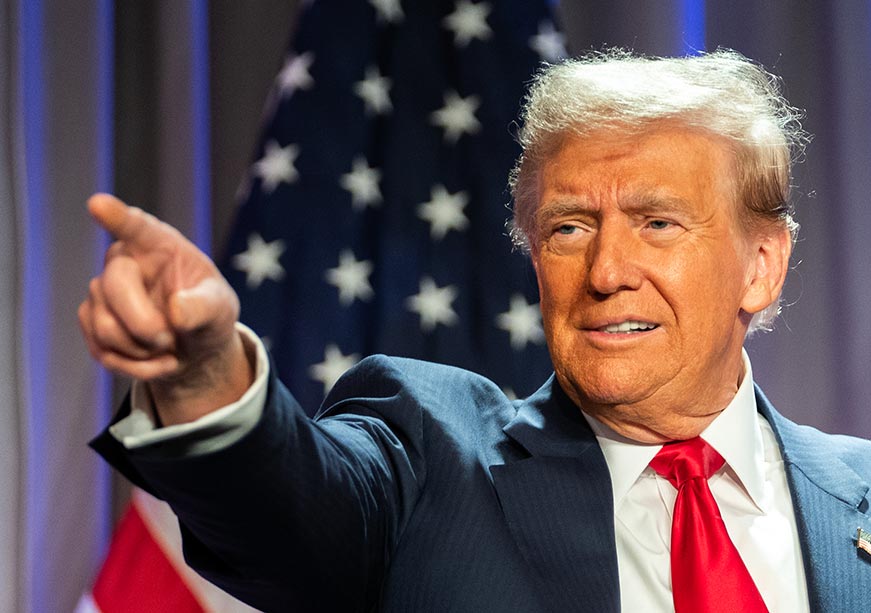-
CENTRES
Progammes & Centres
Location
Trump 2.0 might pave the way for a ceasefire in Ukraine, but the EU is now set to take European security into its own hands

Image Source: Getty
This article is part of the series, "Reignited agendas: Trump’s return and its global repercussions"
Since the days of his election campaign, Donald Trump has emphasised bringing an end to the war in Ukraine. His victory paves the way for possible ceasefire negotiations. The Trump administration will have the bandwidth to deal with broader questions on the European security architecture, which addresses Moscow’s concerns with the North Atlantic Treaty Organization’s (NATO) expansion. Ukraine has come to terms with this development, but has also realised the limits to the West’s support for its territorial defence. In light of Russia’s nuclear sabre rattling since the Kursk incursion on August 2024, as well as the incessant delays in the delivery of approved weapons packages to Ukraine, Trump’s second term at the White House could bring a fresh perspective to ceasing hostility in the region, despite fears that Ukraine will inevitably lose territories.
The Trump administration will have the bandwidth to deal with broader questions on the European security architecture, which addresses Moscow’s concerns with the North Atlantic Treaty Organization’s (NATO) expansion.
Three likely scenarios emerge with Trump’s return. In the first scenario, Washington will impose a 20-year moratorium on Ukraine’s NATO membership, providing military aid to help Kyiv defend against Russian aggression, while establishing an 800 kilometre-long demilitarised zone that would be under the jurisdiction of peacekeepers from countries other than the United States (US) or the United Nations (UN). This approach mirrors the plan proposed by Vice President-elect J.D. Vance. In the second scenario, Washington would cease its military support to Ukraine, nudging Kyiv to negotiate. However, this would be coupled with a guarantee that the US would ramp up support for Kyiv if Moscow refuses to engage in talks and resumes its military offensive. This aligns with the proposal put forward by former US National Security Council members Keith Kellogg and Fred Fleitz. In the third scenario, where Russia continues its armed aggression against Ukraine, Trump would be forced to increase military aid to Ukraine and impose additional sanctions against Russia.
Washington will impose a 20-year moratorium on Ukraine’s NATO membership, providing military aid to help Kyiv defend against Russian aggression, while establishing an 800 kilometre-long demilitarised zone that would be under the jurisdiction of peacekeepers from countries other than the United States (US) or the United Nations (UN).
New directions in US foreign policy vis-a-vis the war in Ukraine are reflected in Trump’s candidate picks, where pro-Ukrainian Republicans such as ex-Secretary of State Mike Pompeo and Nikki Haley were excluded. The new proposed secretaries are China hawks who are less concerned with Russia. Some candidates, such as Vivek Ramaswamy and Elon Musk, who are set to co-run the Department of Government Efficiency (DOGE), have a critical stance on the war in Ukraine. Musk has, in the past, suggested that Ukraine cede Crimea to Russia. For Moscow, despite being satisfied with the outcome of the US election, the Kremlin is not too optimistic about a ceasefire, as it holds the view that parties do not radically influence US foreign policy towards Russia. This was observed in Trump’s first term where Washington imposed punitive sanctions on Russia, including sanctions on the Euro-Russian Nord Stream 2 undersea gas pipeline. Further, no serious attempts were made to implement the Minsk 1 and Minsk 2 agreements, which aimed to end the conflict in the Donbas. Thus, even if a ceasefire is in sight, easing sanctions on Russia in the short term looks unlikely.
Beyond immediate concerns regarding Ukraine, the other priority for Europeans is NATO and the broader question of European security.
While Europeans speculate over Trump’s actions, the alignment between European and American security interests is eroding, irrespective of leadership. With US attention pivoting away from the Euro-Atlantic to the Indo-Pacific and China becoming the country’s primary security threat, NATO will become less important to a less Atlanticist US. Thus, Europeans have no choice but to ramp up their own security—a process that will be accelerated under Trump 2.0, which brings with it a dramatically reduced American commitment to European security. Moreover, Trump’s cabinet picks, including the likes of the allegedly pro-Kremlin Tulsi Gabbard as the Director of National Intelligence, have exacerbated European worries.
With European Union (EU) member states providing over US$ 45 billion in just military aid to Ukraine, the Russia-Ukraine war served as a moment of truth for European security. Several European countries raised their defence spending, offering to raise it even further than the NATO threshold of 2 to 3 percent. This could retain Trump’s interest in the alliance and dispel accusations of ‘free-riding’. Yet, mitigating Trump’s impact would mean that Europeans would have to assume a far greater responsibility in NATO's military command.
Trump’s cabinet picks, including the likes of the allegedly pro-Kremlin Tulsi Gabbard as the Director of National Intelligence, have exacerbated European worries.
The European Commission, under Ursula von der Leyen’s leadership, created the new position of Defence Commissioner, and is advocating for a European Defence Union to build Europe’s defence capabilities through common EU debt. However, progress has been slow and riddled with challenges—member states are reluctant to pool in sovereignty to the EU on security amidst political instability in the key power centres of France and Germany. A lot will depend on whether Europe will maintain a united front, or if countries will choose to bilaterally partner with Trump. Far-right European politicians, emboldened by Trump’s return, may further seek to undermine or obstruct EU policy.
Europe has diversified itself away from Russian energy and is trying to de-risk from China. The final piece of the puzzle in the elimination of previous lopsided dependencies is taking the defence of Europe into its own hands. The security of a dynamic union of 27 states being outsourced to the sentiments of a handful of swing states on the other side of the ocean was an unsustainable reality that needed upending. The shock of a second Trump presidency could be the catalyst that the old continent needs for the consolidation of a resilient and self-reliant Europe.
Shairee Malhotra is the Deputy Director of the Strategic Studies Programme at the Observer Research Foundation.
Rajoli Siddharth Jayaprakash is a Research Assistant with the ORF Strategic Studies programme.
The views expressed above belong to the author(s). ORF research and analyses now available on Telegram! Click here to access our curated content — blogs, longforms and interviews.

Shairee Malhotra is Deputy Director - Strategic Studies Programme at the Observer Research Foundation. Her areas of work include Indian foreign policy with a focus on ...
Read More +
Rajoli Siddharth Jayaprakash is a Research Assistant with the ORF Strategic Studies programme, focusing on Russia's domestic politics and economy, Russia's grand strategy, and India-Russia ...
Read More +